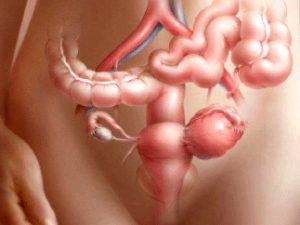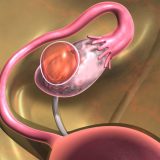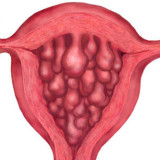Ovarian cancer is one of the most common malignancies in women. It can appear at almost any age, but in most cases occurs at the age of 40 to 70 years.
Ovarian cancer is a difficult to detect disease in cancer gynecology, despite the efforts of the doctors to diagnose it in time. It is so because the symptoms of the cancer are very mild and often they are nonspecific.
They are often identified with diseases of the digestive system. Because of this, patients do not go to the doctor in time for gynecological diagnosis. Such a diagnosis would make it possible to detect the tumor at an early stage of its development and simplify treatment. But in fact, a lot of time is lost from the moment of the appearance of ovarian cancer to the manifestation of significant symptoms that are provoked by significant complications associated with the advanced stage of the cancer.
About 70% of patients begin treatment of the the cancer at the third or fourth stage of the disease. Early diagnosis of ovarian tumor is usually accidental.
Ovarian cancer symptoms
Symptoms of ovarian cancer usually develop for a long time in the body without manifestations. Symptoms appear when the ovarian tumor has grown and developed significantly. It can be ailments in the form of urinary disorders, constipation, flatulence, feeling of heaviness or abdominal pain, pain in the groin.
Early symptoms of the cancer, which are subsequently discussed by patients with the diagnosed disease, are pain in the groin or abdomen, an increase in abdominal volume, rapid saturation during meals and a change in the frequency of urination.
The most common symptom of late-stage ovarian cancer, which already encourages patients to see a doctor, is ascites. It occurs in 30% of patients. Such patients also usually complain of heaviness in the abdominal cavity, although there are often pains with unusual localization in the reproductive organs.
Quite rare symptoms of ovarian cancer are neuralgia – local pain along nerve. This pain usually occurs in the hips or groin. The feeling of heaviness or pressure is usually caused by the weight and volume of the cancer. An increasing size of the tumor can be identified by a sudden urge to urinate, constipation and painful sexual intercourse.
Sometimes, among the signs of the cancer, abnormal bleeding from the genital is noted.
With the progression of the disease there occur: indigestion, selective food intolerance, nausea, vomiting, lack of appetite and difficulties with stool.
A highly developed form of the cancer, like any other cancer, manifests itself in the destruction of the entire body, often this entails weight loss and sharpening of facial lines.
How to detect the ovarian cancer
The initial period of the cancer is usually asymptomatic until the abdomen swells and increases in volume, there is bleeding and pressure on neighboring organs. Pressure on the venous system or even subsequent necrosis is usually manifested by abdominal or groin pain.
When early signs of the cancer appear, the woman should consult a doctor who will prescribe appropriate diagnosis. These includes:
Gynecological examination through the vagina and rectum;
Visual studies – ultrasound examination, which allows to detect changes in the nodules, to determine their size and the degree of tumor process;
Computed tomography and magnetic resonance imaging in some cases complement the ultrasound study of ovarian cancer;
Puncture of the abdominal cavity. In the case of ascites – accumulation of free fluid in the abdominal cavity – can be performed with the selection of cytological fluid;
Laparoscopic diagnosis, however, it has limited application in the case of ovarian diagnosis and is used more often for treatment;
Testing the concentration of tumor markers in serum (marker CA 125 in the cancer, AFP, HCG, LDH in germ cell tumors). The concentration of the CA 125 marker is increased in 80% of patients with ovarian cancer, but it should be remembered that this marker may also increase for other diseases such as endometriosis, uterine fibroids or abdominal inflammation.
Early stage the cancer can be detected during routine medical examinations. When an abnormal bulge is detected in the pelvic area, ultrasound is most often prescribed. Not always such a seal indicates the occurrence of the cancer. It is possible that the seal is the ovarian cyst – a benign formation. Computed tomography or magnetic resonance imaging can confirm the presence of a tumor or the cancer. To identify whether the tumor is cancer, a blood test is prescribed. About half of the patients in the early stages of ovarian cancer have the increased concentration of the tumor marker CA-125.















